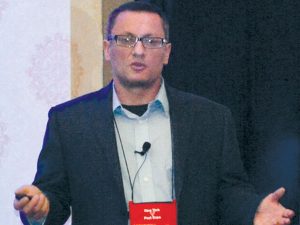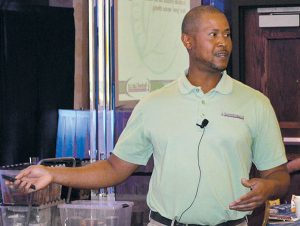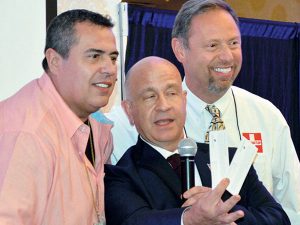Some of the industry’s youngest and brightest delivered educational presentations at the 14th annual New York Pest Expo, held on Veterans Day, Nov. 11.
More than 500 pest management professionals (PMPs) and about 35 exhibitors attended the expo, which featured a posse of “young gun” speakers, including:
- Dr. Kyle Jordan, BCE, BASF’s global product development manager.
- Dr. Grzegorz Buczkowski, associate professor, Purdue University’s Department of Entomology.
- Dr. Jamel Sandidge, research entomologist with Rockwell Labs.
- Lou Sorkin, BCE, consulting entomologist with Entsult Associates.
- Dr. Freder Medina, BCE, BASF’s Western U.S. technical services representative.
- Matthew Remmen, Bayer area sales manager, South Florida and Puerto Rico.
- Dr. Matt Frye, Community Integrated Pest Management (IPM) Extension Area Educator, Cornell University.
“This expo was one of our best-attended yet,” said event organizer Andy Linares, owner of New York-based Bug Off Pest Control Center. “Stay tuned: We’re already working out the details — the theme and speakers’ lineup — for the 2017 New York Pest Expo, our 15th anniversary.”
What follows is just a sampling of the insight shared by this year’s presenters:
- Dr. Jordan: “It typically costs more than $250 million to develop and register a new pest management solution — and that doesn’t factor in the marketing salaries and advertising investments tied to launching the product.”
- Dr. Buczkowski: “Our studies showed that adding mice fecal pellets and urine droplets to bait stations can significantly increase bait consumption by mice…but adding rodent odors to bait stations and multiple-catch traps can significantly hinder efficacy.”
- Dr. Sandidge: “What is green? Green is a comprehensive approach to managing pests by implementing a variety of integrated pest management (IPM) tactics that increase safety and environmental awareness, as well as support the ecological, economic and cultural values of the service location.”
- Sorkin: “Approximately 2,000 species of insects are eaten across the world. The bugs serve as excellent sources of moisture, protein, amino acids, fiber, fat, carbohydrates, ash, calcium, phosphorous and iron.”
- Dr. Medina: “To help your technicians better prepare for ant jobs, have whomever fields the first calls ask the homeowners a series of questions to gather as much information as possible. Taking these notes will help you identify the problem and plan the best ant management strategy. It’s important to understand how bad the infestation is. Ask: How many ants are you seeing — a few or hundreds or thousands? Are the ants trailing or scattered? Where (specific location in a room) and when (early a.m. or p.m.) are you seeing them? What’s their size and color (tiny, medium, big; all the same size, different sizes; one color, two colors)? What are they feeding on (sweets, protein, oils)?”
- Remmen: “Believe it or not, there were four Sharknado movies made. People fear sharks, and tornadoes. But the deadliest animal in the world, by far, is the mosquito. If they made Skeeternado, it would make Sharknado look like a bedtime story.”
- Dr. Frye: “Did you know 90 percent of fleas found on cats and dogs are cat fleas … or that swallow, chimney swift, and bat bugs can be mistaken as bed bugs? Proper pest identification is critical to control.”
- Bug Off Pest Control Center’s Andy Linares hosted the 14th annual New York Pest Expo on Nov. 11, Veterans Day.
- BASF’s Dr. Kyle Jordan, BCE, discussed the research, development and registration process.
- Purdue’s Dr. Grzegorz Buczkowski shared bait station and multiple-catch trap research findings.
- Rockwell Labs’ Dr. Jamel Sandidge presented “The Science of Green.”
- Entsult Associates’ Lou Sorkin, BCE, discussed the immature stages of key insects.
- Entsult Associates’ Lou Sorkin, BCE, shared “Chirps,” chips made with cricket flour, along with Chiridos and other flavorful snacks containing crickets and other insects.
- Syngenta’s Jonathan Davis was among the about 35 exhibitors.
- Bell’s Sheila Haddad was among the about 35 exhibitors.
- BASF’s Dr. Freder Medina shared “rings of protection” tips for ant management.
- Bayer’s Matthew Remmen presented “Zika and General Mosquito Control.”
- Cornell’s Dr. Matt Frye shared updates on bed bugs and fleas.
- Bug Off’s Andy Linares (center) gave away two tickets to a Hornblower dinner cruise around Manhattan to random-drawing winner Cesar Soto (left). Stuart Aust (right) of Bug Doctor, which services the vessel, donated the tickets.
- Linares also gifted a few “young gun” attendees Truman’s Scientific Guide to Pest Management Operations.
- More than 500 PMPs and suppliers attended this year’s expo.
- Bayer’s Shawn Mullin answered pest management professionals’ questions and discussed their products/services.
- Select Insurance’s Frank MacDonald answered pest management professionals’ questions and discussed their products/services.
Photos by Marty Whitford

















Leave A Comment